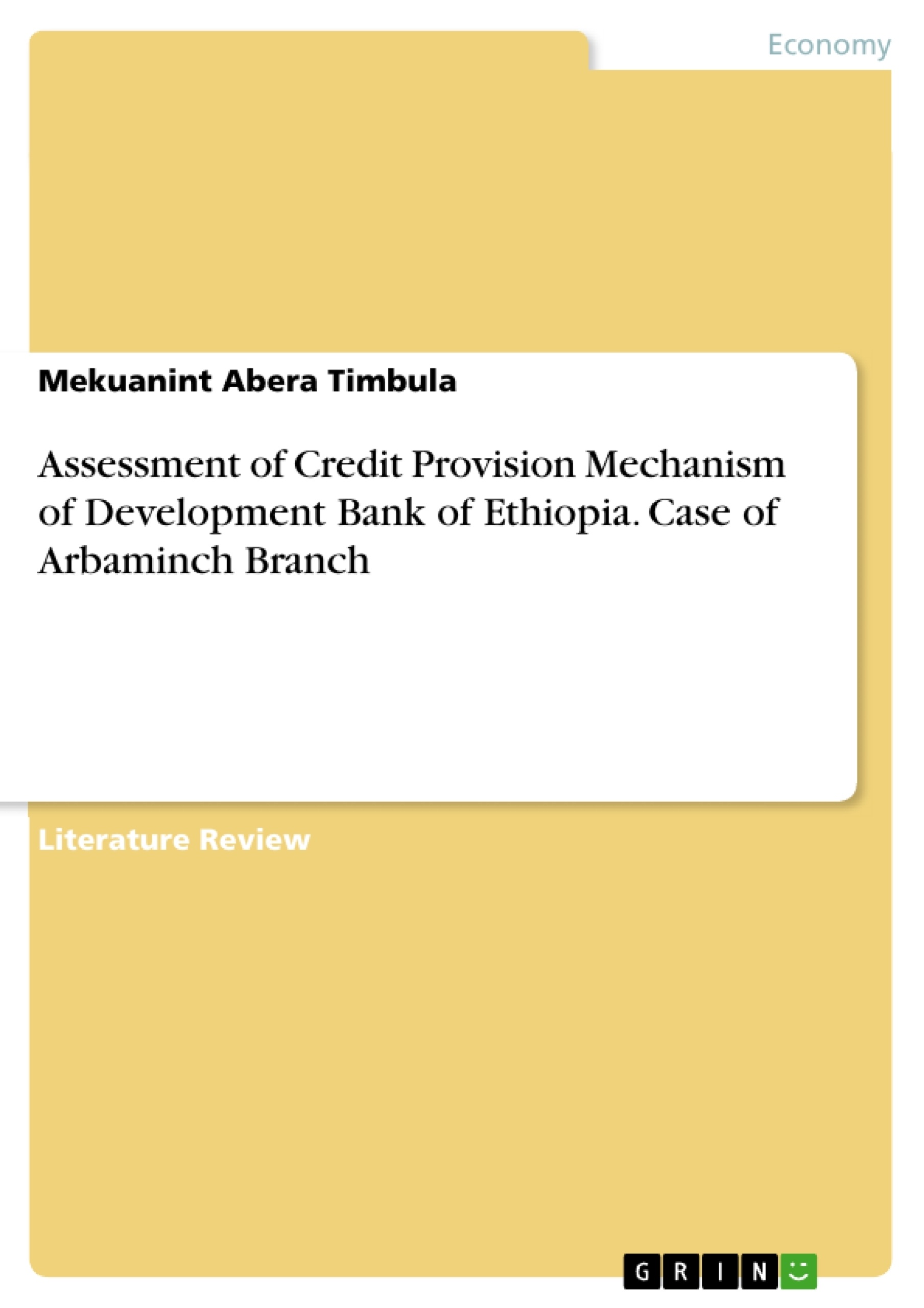The study was focused on the assessment of credit provision mechanism of development bank of Ethiopia Arbiminch branch. To do so the researcher was used both primary and secondary data, among the primary data interview and questionnaire was used. Secondary data like development bank of Ethiopia Arbaminch branch credit manual, books and other documents was used. The study paper addresses an introductory statement of problem from total population of credit customers of development bank of Ethiopia Arbiminch branch by taking 100 samples through judgmental sampling. The collected data was analyzed and presented using descriptive analysis technique like tables percentages, pie chart, bar graphs. Finally based on findings the possible conclusion and recommendation was developed. The findings of the study indicated that the bank‘s lending procedure has a problem. Such as long processing time, limited loan amount, repetition of documents during renewal, time taking and misunderstanding with the customer as well as the problem on determine the value of collateral security.
Key words: Development Bank, credit, Ethiopia
Inhaltsverzeichnis (Table of Contents)
- 1. Background of the Study
- 2. Statement of the Problem
- 3. Methodology
Zielsetzung und Themenschwerpunkte (Objectives and Key Themes)
The objective of this study is to assess the credit provision mechanism of the Development Bank of Ethiopia's Arbaminch branch. It aims to identify challenges in the loan advancing procedure and their impact on the bank's income and profitability.
- Assessment of the Development Bank of Ethiopia's credit provision mechanism.
- Challenges in the loan advancing procedure at the Arbaminch branch.
- Impact of these challenges on the bank's income and profitability.
- Analysis of factors contributing to non-performing loans (NPLs).
- Recommendations for improving the credit provision mechanism.
Zusammenfassung der Kapitel (Chapter Summaries)
1. Background of the Study: This chapter introduces the concept of credit facilities and their importance in meeting borrower requirements. It discusses various types of loan facilities, factors influencing their appropriateness, and the role of banks in providing credit to businesses, governments, and individuals. The chapter emphasizes the significance of credit in economic development and the risks associated with lending. It also explores the concept of credit from the perspective of banks, highlighting their profit-making mechanism through loan issuance and the inherent challenges of balancing liquidity and profitability. The role of the Development Bank of Ethiopia (DBE) in promoting national development through credit services is introduced, along with the challenges posed by the growing number of non-performing loans (NPLs) and their impact on the bank's profitability and image.
2. Statement of the Problem: This section details the challenges faced by the Development Bank of Ethiopia in achieving its objectives related to adequate and timely credit provision. The study highlights the risks inherent in credit provision, including the potential for high default rates due to inadequate credit analysis and over-reliance on collateral. The chapter emphasizes the importance of maintaining a low ratio of non-performing loans (NPLs) as mandated by the National Bank of Ethiopia. It connects the problem of high NPLs to compromised objectivity in credit appraisal and assessment, ultimately affecting the bank's contribution to national development. The chapter also identifies potential problems such as poor risk selection among borrowers, incomplete credit files, and loans exceeding borrowers' capacity, all of which contribute to poor bank performance.
Schlüsselwörter (Keywords)
Development Bank, credit, Ethiopia, loan, non-performing loans (NPLs), credit risk, profitability, liquidity, credit provision mechanism, banking, financial institutions.
Frequently Asked Questions: A Comprehensive Language Preview of a Study on the Development Bank of Ethiopia
What is the main focus of this study?
This study assesses the credit provision mechanism of the Development Bank of Ethiopia's Arbaminch branch. It aims to identify challenges in the loan advancing procedure and their impact on the bank's income and profitability, including analyzing factors contributing to non-performing loans (NPLs) and offering recommendations for improvement.
What are the key objectives of the research?
The key objectives include assessing the Development Bank of Ethiopia's credit provision mechanism; identifying challenges in the loan advancing procedure at the Arbaminch branch; determining the impact of these challenges on the bank's income and profitability; analyzing factors contributing to non-performing loans (NPLs); and providing recommendations for improving the credit provision mechanism.
What are the key themes explored in the study?
Key themes revolve around credit provision, loan procedures, risk assessment, profitability, liquidity, non-performing loans (NPLs), and the overall impact on the Development Bank of Ethiopia's performance and contribution to national development.
What topics are covered in Chapter 1: Background of the Study?
Chapter 1 introduces credit facilities, their importance, various loan types, factors influencing their appropriateness, and the role of banks in credit provision. It emphasizes credit's significance in economic development, associated risks, and the bank's profit-making mechanism. The role of the Development Bank of Ethiopia (DBE) and the challenges posed by non-performing loans (NPLs) are also discussed.
What challenges are addressed in Chapter 2: Statement of the Problem?
Chapter 2 details the challenges faced by the Development Bank of Ethiopia in providing adequate and timely credit. It highlights risks like high default rates due to inadequate credit analysis and over-reliance on collateral. The importance of a low ratio of NPLs is stressed, connecting high NPLs to objectivity issues in credit appraisal and assessment. Problems like poor risk selection, incomplete credit files, and loans exceeding borrowers' capacity are also identified.
What are the key words associated with this study?
Key words include Development Bank, credit, Ethiopia, loan, non-performing loans (NPLs), credit risk, profitability, liquidity, credit provision mechanism, banking, and financial institutions.
What is the overall structure of the provided text?
The provided text is a comprehensive language preview including the title, table of contents, objectives and key themes, chapter summaries, and keywords. It offers a structured overview of the research study.
- Quote paper
- Mekuanint Abera Timbula (Author), 2018, Assessment of Credit Provision Mechanism of Development Bank of Ethiopia. Case of Arbaminch Branch, Munich, GRIN Verlag, https://www.grin.com/document/452340



